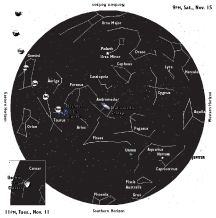
|
Volume 16, Issue 46 - November 13 - November 19, 2008
|
|
Columns |
 |
Sky Watch by J. Alex Knoll
Gobs of Stars
Their light spans both distance and time
By 9pm, the constellation Andromeda shines directly overhead. In Greek mythology, this princess was sacrificed by her parents to spare their coastal kingdom from the ravages of a mighty sea monster. Flying overhead astride the winged horse Pegasus, the great hero Perseus rescued princess and defeated the monster.
In astronomy, the constellation Andromeda is flanked by Perseus and Pegasus, while her father, Cepheus, and mother, Cassiopeia, hover above. Amid the constellation is the Andromeda galaxy, a spiral galaxy like our own Milky Way and our nearest galactic neighbor. Even so, at 2.5 million light years distance, it is the farthest object visible to the naked eye, appearing as a faint smudge.
Thursday’s full moon hovers near another faint smudge — this one a cluster of stars. The moon Nov. 13 rises in the northeast as the sun sets in the southwest around 5pm. The red-giant Aldebaran, the eye of Taurus the bull, glares some 10 degrees below the moon, while the Pleiades star cluster hovers above by less than five degrees — half the width of your outstretched fist.
Monday the moon rises after 10pm, and behind it by one-half degree is the blurred light of the Beehive star cluster. At the center of the constellation Cancer, the Beehive is one of the easiest clusters to spot, and it has been viewed since ancient times, long before the advent of the telescope. It was one of the first “nebulae” that Galileo trained his telescope on, discovering that it was actually “a mass of more than 40 small stars.” Today we know that more than 350 stars form the Beehive and that, at 577 light years distant, it is the nearest cluster to our own solar system.